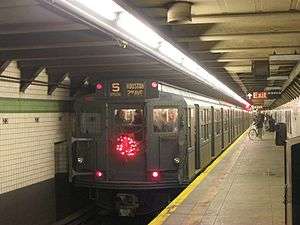R6 (New York City Subway car)
| R6 | |
|---|---|
 R6 car 1000 at 23rd Street on the Holiday Shopper's Special | |
| In service | 1935-1977 |
| Manufacturer | American Car and Foundry Company, Pullman Standard, Pressed Steel Car Company |
| Built at | Berwick, Pennsylvania |
| Family name | Arnines |
| Constructed | 1935–1936 |
| Number built | 500 |
| Number preserved | 7 |
| Number scrapped | 493 |
| Formation | motorized single units (Half-width operator's cab at each end; conductor controls on exterior) |
| Fleet numbers | 900-1399 |
| Capacity | 56 seats |
| Operator(s) |
Independent Subway System New York City Transit Authority |
| Specifications | |
| Car body construction | Riveted steel |
| Car length | 60 feet 2 1⁄2 inches (18.35 m) |
| Width | 10 ft 0 in (3.05 m) |
| Height | 12 feet 1 5⁄8 inches (3.70 m) |
| Doors | 8 sets of 45 inch wide side doors per car |
| Weight | 84,228 lb (38,205 kg) |
| Traction system | Westinghouse ABF type UP143B switch group, with XM-29 master controller using Westinghouse 570-D5 or General Electric 714-C1, 714-C2 190 hp (142 kW) per motor. Two motors per car (both on motor truck, trailer truck not motorized). |
| Power output | 190 hp (142 kW) per traction motor *Motor Power: 190 hp (142 kW) per motor |
| Electric system(s) | 600 V DC Third rail |
| Current collection method | Contact shoe (Top running) |
| Braking system(s) | WABCO Schedule AMUE with UE-5 universal valve, ME-23 brake stand, and simplex clasp brake rigging |
| Coupling system | WABCO H2A |
| Headlight type | incandescent light bulb |
| Track gauge | 4 ft 8 1⁄2 in (1,435 mm) |
The R6 was a New York City Subway car model built from 1935 to 1936 for the city-operated Independent Subway System by three manufacturers under separate orders, the American Car and Foundry Company, Pullman Standard, and Pressed Steel Car Company. The cars were a continuation of the R4 fleet and look almost the same, except that the R6 had a two-pane front window compared to the R4's one-pane window.
Description
The R6s were numbered 900-1399. The contract had three separate orders from different manufacturers due to the large order. The R6 separate orders were R6-3 (American Car and Foundry Company, cars 900-1149), R6-2 (Pullman Standard, cars 1150-1299), and R6-1 (Pressed Steel Car Company, cars 1300-1399). Regardless, all three orders were identical to each other.
The R6s were ordered to equip extensions of the IND in Brooklyn and Queens.[1] They were used for service on the IND exclusively until 1968 or 1969, when many were displaced from the IND by the new R40s and R42s and transferred to the East New York Yard.
Many R6s were replaced by the R44s. The transferred cars ran on the Eastern Division until 1977, when they were finally replaced by the R46s.
Preservation
- R6-3 cars 923 and 925 - converted to revenue collection cars and formerly renumbered R247 and R248, respectively. Once they were no longer needed as work cars, they were purchased and preserved by Railway Preservation Corp, stored in Coney Island Yard for many years until they were moved again to 207th Street Yard. Restoration will be needed if these cars are to run again.
- R6-3 car 978 - repurposed into a deli (Golden's Deli) at the Staten Island Mall until the Deli was closed in January 2012. The owners of the Deli have placed it in storage, but have ultimately decided to sell the car.[2][3] The car was successfully sold and is being restored by a private owner.[4]
- R6-3 car 983 - originally on private property in Jacksonville, Florida, where it was used as a tool shed until 2014. It was purchased by the Craggy Mountain Line based in North Carolina in early 2013 and is being restored to operating service for their museum.[5] The car uses trucks from scrapped R32s.[6]
- R6-3 car 1000 - preserved by Railway Preservation Corp. and restored.
- R6-3 car 1144 - preserved at the Buckinghamshire Railway Centre in England, although it does not have trucks. It was converted into a cafeteria for the museum.
- R6-1 car 1300 - preserved by Railway Preservation Corp. and restored.
Car 1208 was previously preserved by the New York Transit Museum. However, it was scrapped during the 1980s, along with several other museum cars. It would have been the only R6-2 preserved if it wasn’t scrapped.[7]
References
- ↑ Cunningham, Joseph; DeHart, Leonard O. (1993). A History of the New York City Subway System. J. Schmidt, R. Giglio, and K. Lang.
- ↑ "Authentic 1935 NYC R6 Subway Car Ind 978 New York City R1 R9 BMT Train - eBay". eBay. Archived from the original on 19 October 2014.
- ↑ "Rare NYC subway car on sale in Brooklyn lot for $24,000". NY Daily News. Archived from the original on 15 October 2014.
- ↑ http://www.thejoekorner.com/photos/nyctind/goldens-car/index.htm
- ↑ "The Coney Island 983". The Art of Abandonment.
- ↑ https://www.facebook.com/permalink.php?story_fbid=947173635305753&id=250416924981431
- ↑ https://www.nycsubway.org/wiki/The_Independent_Fleet_(1932-1939)
Further reading
- Sansone, Gene. Evolution of New York City subways: An illustrated history of New York City's transit cars, 1867-1997. New York Transit Museum Press, New York, 1997 ISBN 978-0-9637492-8-4